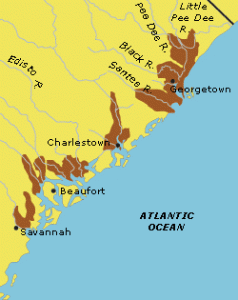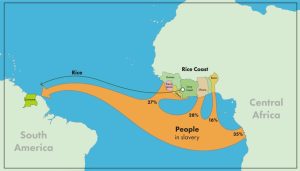Learning Objectives
- Be able to name and locate rice-growing regions on the map of the African continent
- Understand the defining role of rice in West African history and culture
- Trace the path of rice to the Carolina coast
Background
African Indigo and Rice cultivators:
Africans were forcefully transported to South Carolina Low Country for their rice-production knowledge to be enslaved on rice and indigo plantations of Savannah, Beaufort, and Charleston. Indigo and Rice Cultivators dominated the second wave of people imported into Low Country after 1750. Most scholars now believe that much of the technology involved in rice cultivation along coastal South Carolina and Georgia, originated in rice-producing regions in West Africa, and was transferred across the Atlantic by slaves. “The plantation owners purchased slaves from various parts of Africa, but they greatly preferred slaves from what they called the “Rice Coast” or “Windward Coast”—the traditional rice-growing region of West Africa, stretching from Senegal down to Sierra Leone and Liberia. The plantation owners were willing to pay higher prices for slaves from this area, and Africans from the Rice Coast were almost certainly the largest group of slaves imported into South Carolina and Georgia during the 18th century (Creel 1988:29–37; Littlefield 1981:34–36; Curtin 1969; Donnan 1935).” ~ NPS
Role of rice in the rise of great pre-colonial West African states:
There is a common perception that Rice originated exclusively in Asia. However, there is ample evidence that West Africans domesticated and cultivated rice for thousands of years, long before the arrival of the Europeans. Before this evidence came out, there was also a misconception that Europeans brought the seeds and the know-how of rice agriculture from Asia to West Africa.
Now there is evidence that rice was grown 3,500 years ago in the Niger Delta. West African peoples developed a very sophisticated rice planting method that was adapted to some of the most challenging landscapes including the wetlands and mangrove swamps. History also shows that despite the Transatlantic African slave trade that ravaged the continent from its population, rice production increased and continued to play a major role in economic trading between Africans, Asians, and Middle Easterns. Rice production in West Africa provided solid social and economic foundations in areas of West Africa where Mali, Senegal, Guinea, and Ghana are now located.
In fact, there are studies that also demonstrate West Africa’s role in developing of the most domesticated rice plant, Oryza glaberrima, and the high water management systems and cultivation techniques used to grow that river. Today, West African countries like Senegal and Guinea Bissau continue to play an important role in scientific research in different varieties of rice that can adapt to the challenges posed by climate change. In fact, many agricultural research centers and institutions such as the West African Rice Development Association in Liberia and the Senegal Institute for Agricultural Research are credited for their roles in developing new varieties of rice that combine African indigenous rice seeds with others. These new developments have been successful in the region.
Source: https://www.berghahnbooks.com/downloads/OpenAccess/KnoerrUpper/KnoerrUpper_09.pdf
Rice-growing landscapes (i.e. mangrove swamps) as a refuge from external forces, including pre-colonial Islamic incursions and Atlantic slave traders:
Before the arrival of European colonialists, the continent experienced incursions from Oriental Islamists who colonized part of the continent prior to Europeans. These rice-growing landscapes played important roles for Africans. Mangroves swamps especially, which is often associated with the imaginary of this region served that evokes the topographical served as a refuge from various external forces and foes, from centuries-old Islamic incursions to more recent iconoclasts, from Atlantic slavers to more recent civil strife.
Materials and Resources
- Blank Map
- Crayons, colored pencils
- Geography of West Africa focusing on the Upper Guinea Coast formerly called Rice Coast by European colonizers:


Source: https://www.sapiens.org/culture/african-rice-new-world/Source: https://www.nps.gov/ethnography/aah/aaheritage/lowCountryA.htm- websites:
- How Jollof rice became West Africa’s iconic dish and a point of banter between Africans
- African rice (Oryza glaberrima): History and future potential
- Recipe for Jollof Rice
- Ingredients-
- 1/3 cup oil (vegetable/canola/coconut, not olive oil)
- 6 medium-sized fresh plum/Roma tomatoes, chopped, OR a 400-gram tin of tomatoes
- 6 fresh, red poblano peppers (or 4 large red bell peppers), seeds discarded
- 3 medium-sized red onions (1 sliced thinly, 2 roughly chopped), divided
- 1/2 to 1 hot pepper, or to taste (yellow Scotch bonnets are my favorite)
- 3 tablespoons tomato paste
- 2 teaspoons (Caribbean/Jamaican-style) curry powder
- 1 teaspoon dried thyme
- 2 dried bay leaves
- 5 to 6 cups stock (vegetable, chicken, or beef) or water, divided
- 2 teaspoons unsalted butter (optional), divided
- 4 cups uncooked converted long-grain rice or golden sella basmati, rinsed
- Salt, to taste
- Black and white pepper, to taste
- Extra: sliced onions, tomatoes
Opening Activity: ~15 minutes
- Group Discussion Question: What geographic features, regions, and countries can you identify in West Africa?
Content Lesson and Activities: ~60 minutes
- Introduce Content
- Review of the geography of West Africa focusing on the Upper Guinea Coast formerly called Rice Coast by European colonizers;
- Defining the role of rice in the rise of great pre-colonial West African states, including Ghana, Mali, and Songhai;
- Rice-growing landscapes (i.e. mangrove swamps) as a refuge from external forces, including pre-colonial Islamic incursions and Atlantic slave traders;
- “Sacred Rice”: Rice as a symbol of ethnicity, spirituality, and continuity of the Jola culture;
- Rice growing and consumption in modern West African societies;
- The transfer of Rice culture from West Africa to South Carolina.
- Activity
- Print out or pull up on iPad the blank map of Africa and have students color and label the rice-producing regions of West Africa.
- Make and sample some jollof rice, a popular West African dish
Closing Activity: ~15 minutes
- Journal Reflection Question: What’s your connection to rice? For example, do you have a favorite dish that uses rice? Does someone in your family make a special rice meal?
Media Attributions
- carolina coast
- map
